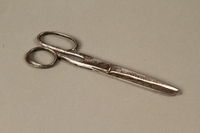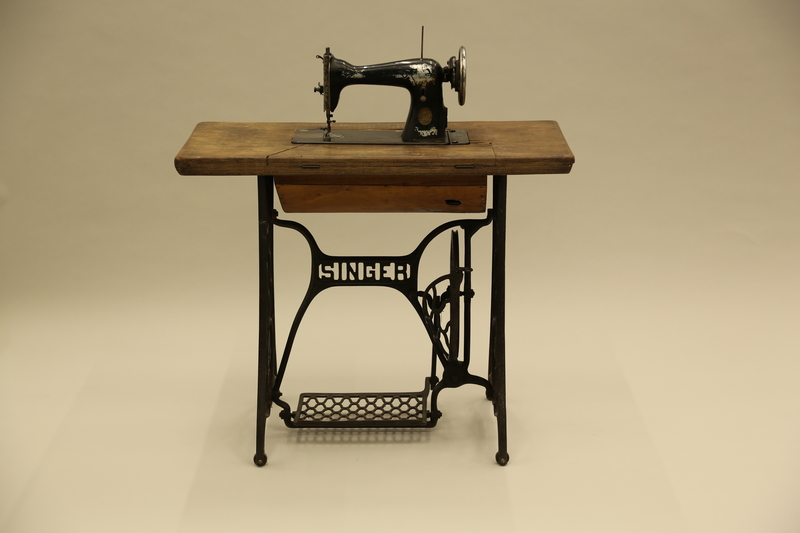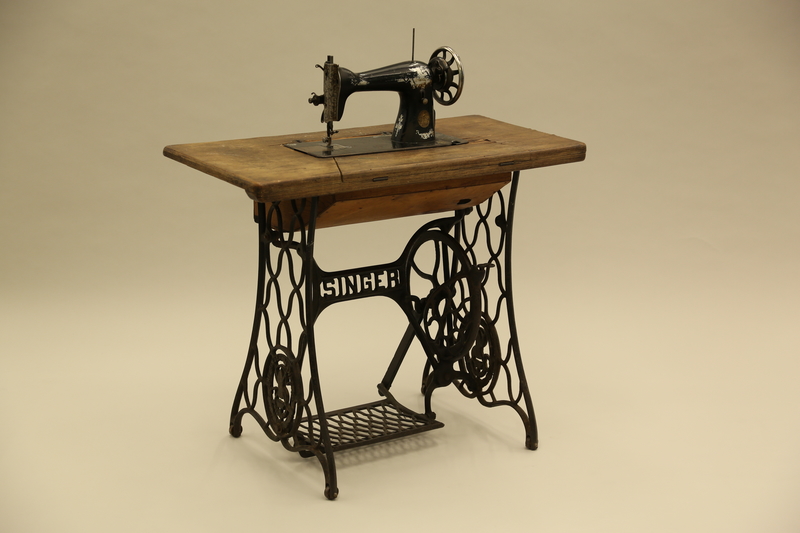Overview
- Brief Narrative
- Singer sewing machine mounted on a wooden table with wrought iron legs that Ratza (Reyza) Solomonskaya used to earn her livelihood as a seamstress in the small town of Pepeni, Romania (now Pepeny, Moldova), during the Holocaust. She lived with her husband, a shoemaker named Mark Solomonski, and their teenage daughters, Khayka and Ita. During World War II, their town was in Bessarabia, a historically contested region, which had been part of Romania following World War I until it was ceded to the Soviet Union in June 1940. In June 1941, during the German invasion of the Soviet Union, Romania recaptured the region. On July 13, Romanian soldiers and gendarmes entered Pepeni and began rounding up Jews with the help of some local residents. Ratza left her sewing machine and scissors with neighbors for safekeeping. After being held for four days with no food or water, Ratza, Mark, Khayka, and Ita were among the approximately 250 Jews massacred when their captors and local collaborators opened fire on them. Several days later, a designated commission requisitioned and redistributed the property left behind by the murdered Jews. Ratza’s neighbors already had her sewing machine and it was not among those redistributed items. The family maintained possession of the machine and scissors until they were acquired by the Museum in 2017.
- Date
-
manufacture:
1927
use: before 1941
- Geography
-
manufacture:
Clydebank (Scotland)
use: Pepeny (Moldova)
- Credit Line
- United States Holocaust Memorial Museum Collection
- Markings
- a. front, lower right, embossed : THE SINGER MANFG. CO. / TRADEMARK
a. base, front right corner, engraved : Y4774539
d. sides, embossed : THE SINGER MANFG. CO. / TRADEMARK
d. center, wrought : SINGER - Contributor
-
Manufacturer:
Singer Sewing Machine Corp.
Subject: Ratza Solomonskaya
- Biography
-
Ratza (Reyza) Solomonskaya (1896-1941) was born in Pepeni, Russia (now Pepeny, Moldova). Following World War I, the region became part of Romania. Ratza was a seamstress and sometimes went by the name Roza. She was married to Mark Solomonski (1898 –1941), a shoemaker from Pepeni. They had two daughters, Khayka (1927 -1941) and Ita (1929–1941). The Solomonski family was part of a small Jewish community spread across several neighboring towns in the region just south of Bălți.
On June 28, 1940, Romania was forced to cede Bukovina and Bessarabia, where Pepeni was located, to the Soviet Union. During the German invasion of the Soviet Union, in summer 1941, Romania, a German ally, recaptured the region and many of the Jews in Bălți took refuge in smaller towns, including Pepeni. Romania had a long tradition of anti-Semitism, and the government sought to remove Jews from its provinces by “cleansing the terrain”, a codename for mass-execution. On July 13, Romanian soldiers and gendarmes entered Pepeni and organized small groups of local residents to help them force Jews like Ratza and her family from their homes and into the local town hall. Many carried their valuables with them, but before leaving her home, Ratza entrusted her sewing machine to a neighbor for safekeeping. Ratza’s family was locked into the building along with approximately 250 of their Jewish neighbors, refugees from Bălți, and many others from neighboring towns. The doors were locked and no one was allowed to have food or water for four days. On the fourth evening, shots were heard from a nearby town, and the leader of the Gendarme said the Red Army and Jews from further away were threatening to enter the village, set fire to the buildings, and release those Jews being held. The leader tossed a grenade into the town hall and then some of the men under his control opened fire on those inside. Others wielded bats to keep people from trying to escape out the open windows, though a few people did manage to get past them and survive. Ratza, Mark, Khayka, and Ita were murdered during the massacre.
That night, the gendarmes ordered that anyone still living be killed and that all the bodies in the town hall be carted off and dumped in nearby stone mines. The following day, local women and draftees were forced to wash out the blood soaked town hall. Several days later, a commission consisting of high ranking locals, including the mayor and head of the tax department, was formed to requisition the property left behind by the murdered Jews and distribute their valuables to those locals considered distinguished and others that had helped carry out the massacre. Ratza’s neighbors already had her sewing machine in their possession and it was not among those items redistributed by the commission. After 1944, many of the perpetrators, including 19 locals and the gendarme in charge, were brought to trial and held accountable for the mass murder, though some did receive amnesty following the death of Stalin.
Physical Details
- Language
- English
- Classification
-
Tools and Equipment
- Category
-
Sewing equipment and supplies
- Object Type
-
Sewing machines (lcsh)
- Genre/Form
- Sewing--Equipment and supplies. Sewing machines.
- Physical Description
- a. Heavy, black painted, cast iron, treadle powered sewing machine attached to the right side of a rectangular base plate. The L-shaped machine has a vertical body with a horizontal arm that extends to the left, suspended over the base plate. Attached to the right end of the machine are a spoked wheel and pulley disc, with an adjustment lever on the front and bobbin winder on the curved belt guard above the pulley. The arm has holes along the top for a spool pin (b) and rods. At the left end is a rectangular sewing head with tension levers and thread guides covered by a fitted, silver colored metal face plate embossed with floral scrollwork and stippling. Two vertical rods pass through the head with a needle on the bottom of one and an L-shaped presser foot on the other. A semi-circular slotted plate is fixed in the base below the needle. To the left of the plate is a cutout with a rectangular insert. On the back, where the arm meets the body, is a flat metal disc embossed with floral scrollwork. A circular shuttle mount attaches to the base underside, below the needle. There is a flat, narrow rectangular extension with 2 treadle belt holes on the right base and 2 mounting lugs on the back to attach the machine to a tabletop (c). The machine has remnants of gold, bronze, and silver painted geometric and floral designs. An engraved manufacture’s logo and serial number are attached.
b. Cylindrical silver painted metal spool holder with flat ends.
c. Flat, rectangular wooden tabletop with rounded corners and a sloped body to store a treadle powered sewing machine (a). At the front center is a hinged, horizontal rectangular leaf with an angled end that folds flush into the top. At the center is a rectangular hole with 2 circular metal mounts for a sewing machine on the inner edge. The body, nailed to the underside, has a flat rectangular back with a central rectangular hole and flat sides that follow the contour of the rounded underside, which is nailed to them and slopes upward at the front. There are 2 treadle belt holes on the right bottom.
d. Black, cast iron table base for a treadle powered sewing machine (a). It has 2 wrought, lattice work legs, each with an embossed manufacturer’s logo and 2 small wheeled feet. The legs are connected by an H-shaped cross brace with the manufacturer’s name wrought in the center. A large spoked, treadle belt wheel with a grooved edge and a curved belt guard are attached on the right. A pivoting, rectangular, lattice work treadle is attached near the bottom. It is connected to the wheel by a large vertical rod at the back right. The top of each leg is flat, so that it can be secured to the underside of a wooden storage tabletop (b). - Dimensions
- a: Height: 8.875 inches (22.543 cm) | Width: 16.500 inches (41.91 cm) | Depth: 7.000 inches (17.78 cm)
b: Height: 3.125 inches (7.938 cm) | Width: 0.125 inches (0.318 cm) | Depth: 0.125 inches (0.318 cm)
c: Height: 8.125 inches (20.638 cm) | Width: 35.875 inches (91.123 cm) | Depth: 17.750 inches (45.085 cm)
d: Height: 26.625 inches (67.628 cm) | Width: 23.750 inches (60.325 cm) | Depth: 18.875 inches (47.943 cm) - Materials
- a : cast iron, metal, paint
b : metal, paint
c : wood, metal
d : cast iron, metal
Rights & Restrictions
- Conditions on Access
- No restrictions on access
- Conditions on Use
- No restrictions on use
Keywords & Subjects
- Topical Term
- Holocaust, Jewish (1939 -1945)--Moldova--Pepeny. World War, 1939-1945--Atrocities--Moldova. World War, 1939-1945--Atrocities--Romania. Holocaust, Jewish (1939 – 1945)--Personal narratives. Massacres--Romania. World War, 1939-1945--Collaborationists--Romania. Jews--Persecutions--Moldova.
- Geographic Name
- Pepeny (Moldova) Moldova. Clydebank (Scotland)
- Corporate Name
- Singer Sewing Machine Company
Administrative Notes
- Legal Status
- Permanent Collection
- Provenance
- The sewing machine was acquired by the United States Holocaust Memorial Museum in 2017.
- Funding Note
- The cataloging of this artifact has been supported by a grant from the Conference on Jewish Material Claims Against Germany.
- Record last modified:
- 2024-01-16 15:10:34
- This page:
- https://collections.ushmm.org/search/catalog/irn562283
Download & Licensing
In-Person Research
- By Appointment
- Request 21 Days in Advance of Visit
- Plan a Research Visit
- Request to See This Object
Contact Us
Also in Ratza Solomonskaya collection
The collection consists of a Singer sewing machine with table and sewing scissors used by Ratza Solomonskaya in Pepeni, Romania (now Pepeny, Moldova), before and during the Holocaust.
Date: approximately 1927-1941 July

Singer sewing scissors used by Jewish Romanian woman who was killed during a massacre
Object
Singer sewing scissors that Ratza (Reyza) Solomonskaya used to earn her livelihood as a seamstress in the small town of Pepeni, Romania (now Pepeny, Moldova), during the Holocaust. She lived with her husband, a shoemaker named Mark Solomonski, and their teenage daughters, Khayka and Ita. During World War II, their town was in Bessarabia, a historically contested region, which had been part of Romania following World War I until it was ceded to the Soviet Union in June 1940. In June 1941, during the German invasion of the Soviet Union, Romania recaptured the region. On July 13, Romanian soldiers and gendarmes entered Pepeni and began rounding up Jews with the help of some local residents. Ratza left the scissors and her Singer sewing machine with neighbors for safekeeping. After being held for four days with no food or water, Ratza, Mark, Khayka, and Ita were among the approximately 250 Jews massacred when their captors and local collaborators opened fire on them. Several days later, a designated commission requisitioned and redistributed the property left behind by the murdered Jews. Ratza’s neighbors already had her sewing machine and it was not among those redistributed items. The family maintained possession of the machine and scissors until they were acquired by the Museum in 2017.






